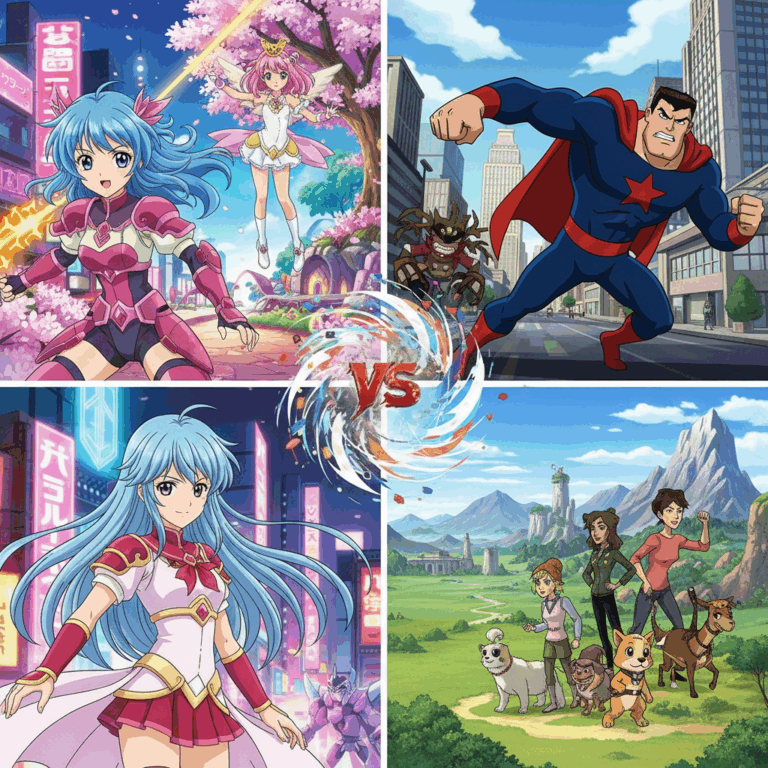Visual and technical differences
Japanese and Western animation present visual features and techniques that profoundly distinguish them. Both share the frame-by-frame drawing technique, but their execution varies considerably.
These differences are not only due to aesthetic tastes, but also to historical and economic conditions that shape production and style in each region.
By understanding these particularities, one can better appreciate the richness and diversity that each tradition brings to the world of animation.
Design style and features
Japanese anime is notable for a stylized design, with characters with large, expressive eyes and exaggerated proportions that emphasize emotions.
In contrast, Western animation covers a wider range from graphic realism to caricature, showing variety in visual styles.
This differentiation also reflects different cultural priorities in visual representation and communication.
Thus, the Japanese style seeks to connect emotionally through iconic details, while the Western style explores multiple forms and expressions.
Production and number of frames
Japanese production uses fewer frames per secondfocusing the detail on key scenes to create a strong visual impact.
In contrast, Western animation prefers a higher number of frames, which guarantees smoother and more continuous movements.
This technical difference also arises from budgetary limitations in Japan, which fostered innovations in selective animation.
Thus, in anime only the essential parts are animated during extensive dialogues, reinforcing the narrative and psychological emotion.
Narrative and thematic contrasts
Anime narratives are characterized by a deep focus on the psychology and emotions of the characters, frequently exploring complex philosophical themes.
In contrast, Western animation usually prioritizes action, humor, and immediate entertainment, with a faster and more direct narrative pace.
These differences reflect the distinct cultural views on time and storytelling in both traditions.
Psychological and philosophical approach to anime
The anime focuses on introspection and emotional development, addressing themes that invite reflection on existence and identity.
It uses deep dialogue and extended scenes to show the characters' inner world, creating an intense connection with the viewer.
This approach opens up space to explore ethical, social, and philosophical dilemmas within complex and mature narratives.
Priorities in Western Narrative
Western animation prioritizes dynamic action and clear narrative that seeks to quickly capture the audience's attention.
The content is usually geared towards humor, adventure and direct messages, adapting to family and commercial entertainment.
This approach emphasizes visual impact and speed in conflict resolution, leaving less room for psychological introspection.
Use of time and narrative rhythm
In anime, narrative time is flexible, allowing for paused scenes that highlight details and emotional states with calm and depth.
In contrast, Western animation uses a more agile pace and short narrative structures to maintain continuous interest and visual fluidity.
This difference in the use of time influences how each style builds the atmosphere and the viewer's connection with the story.
Cultural perspectives reflected
Japanese and Western animation reveal different cultural perspectives which are reflected both in the realism of the characters and in the visual elements.
These differences are manifestations of individual values and sensibilities that influence how stories and characters are represented.
Exploring these particularities helps to better understand the cultural richness that each tradition brings to the art of animation.
Realism in personality vs. graphic
Anime prioritizes the psychological realism and the emotional depth of the characters, even when their designs are stylized.
Conversely, Western animation tends to seek a realism more focused on graphic and physical appearance, giving importance to visual details.
This difference reflects cultural views: Japan values internal complexity, while the West emphasizes external image and visual storytelling.
Thus, the Japanese public connects with multifaceted characters, while the Western public enjoys visually striking or realistic figures.
Details and symbolism in animation
The anime stands out for its meticulous attention to symbolic details, such as everyday objects or natural elements that enrich the story.
For example, prolonged scenes show leaves, petals, or subtle movements to convey deep emotions and meanings.
In contrast, Western animation tends to focus on action and obvious visual elements, valuing the transcendent over the ephemeral.
This approach reflects a different cultural sensitivity towards the perception of time and the value of the seemingly insignificant.
Impact and influence on the global industry
Japanese and Western animation have profoundly influenced the global industry, generating a creative exchange that expands styles and narratives.
This impact is reflected in the adoption of visual and thematic elements that enrich both productions and audiences worldwide.
Transformations and collaborations allow for a dynamic cultural dialogue, expanding the reach and diversity of the animated medium.
Stylistic adaptations and fusions
Western productions have incorporated characteristic features of anime, such as detailed designs and action sequences inspired by martial arts.
Series like Avatar: The Last Airbender and Teen Titans They demonstrate this fusion, adopting both visual and narrative elements from anime.
Cinema has also been influenced, with films such as The Matrix They show a clear influence of Japanese classics such as Ghost in the Shell.
This aesthetic and thematic mix enhances innovation, generating new forms of expression in global animation.
International collaborations and co-productions
Recently, the rise of co-productions has made it possible to unite Japanese and Western talents, merging diverse styles and techniques.
Movies like Batman Ninja and series like Star Wars: Visions These creative alliances exemplify how they break down cultural barriers.
These collaborations broaden the audience and facilitate the exchange of ideas, enriching both traditions and their markets.
The result is a more diverse, globalized animation with innovative potential that benefits the entire industry.






